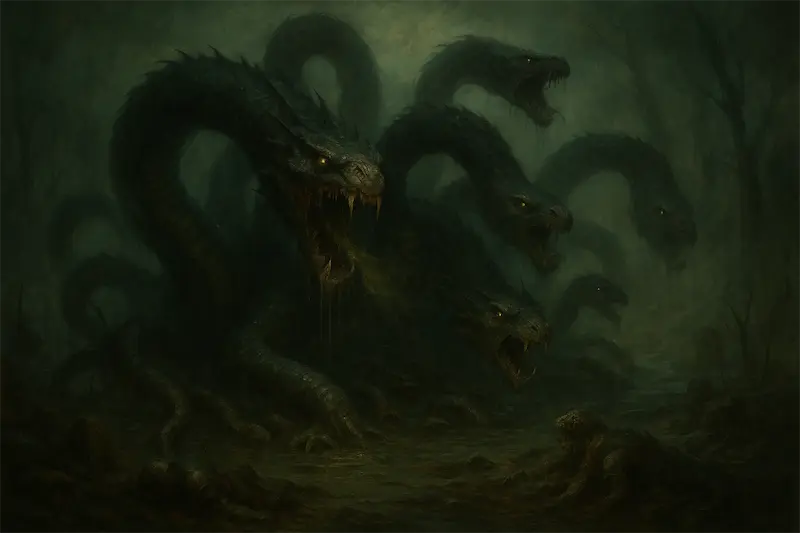Introduction to Hydra
Hydra, also known as the Lernaean Hydra, is one of the most infamous monsters in ancient Greek mythology. Known as a terrifying multi-headed beast living in the swamps of Lerna, the Hydra symbolizes chaos, immortality, destruction, and unstoppable proliferation. It was a nightmare for Greek heroes and served as one of the greatest challenges in the Twelve Labors of Heracles (Hercules).
More than just a multi-headed creature, Hydra has come to represent complex dangers and problems—social, psychological, or biological—that grow stronger and more widespread the more you try to eliminate them. Its image has transcended mythology, becoming a powerful metaphor in literature, philosophy, psychology, and modern culture.
Appearance and Characteristics of the Hydra
Monstrous Appearance
Hydra is usually depicted as a giant serpent with multiple heads, ranging from five to one hundred, depending on the myth. Each head resembles a venomous snake, with sharp fangs capable of delivering a lethal bite.
- Number of heads: In Apollodorus’s Bibliotheca, Hydra is described as having nine heads—eight mortal and one immortal at the center.
- Body: Massive and serpentine, with scales as hard as steel, impervious to most weapons.
- Unique ability: Every time a head is cut off, two or even three more would grow in its place, making it almost impossible to kill through conventional means.
Behavior
Hydra lived in the swamps of Lerna, where it terrorized nearby villages, slaughtered livestock, and kept the region in constant fear. It was notoriously aggressive, attacking any creature that entered its territory.
In addition to its ferocious combat abilities, Hydra’s venom was considered a biological weapon. Its breath and blood were said to poison entire areas, withering plants, contaminating water, and spreading disease.
Origins and Symbolism of the Hydra
Mythological Origins
Hydra was the offspring of Typhon and Echidna—the fearsome duo known as the “parents of monsters” in Greek mythology. Its siblings include famous beasts like Cerberus, Chimera, Orthrus, and the Sphinx, forming the most terrifying monster family in mythology.
Hydra was raised by the goddess Hera with the intention of destroying Heracles, whom she despised.
Symbolic Meaning
Hydra has long symbolized:
- Uncontrollable proliferation: Hydra represents issues like crime, fear, pandemics, and wars—problems that grow worse the more they are suppressed.
- Immortality: Its central head was considered immortal, reflecting threats that cannot be eliminated by brute force alone but require wisdom, strategy, and patience.
- Chaos: Hydra embodies endless chaos, reflecting the complexity of problems that cannot be solved using traditional methods.
Physical Features and Powers of the Hydra
Supernatural Powers
- Regenerating heads: Hydra’s most iconic trait is its regenerative ability. When a head is cut off, two more grow back, making it nearly invincible.
- Lethal venom: Hydra’s venom was so deadly that even after its death, Heracles used it to coat his arrows, giving them the power to kill giants and other powerful beings.
- Overwhelming physical strength: Hydra could crush enemies with its massive jaws, while its thick, armored hide made it immune to most weapons.
Symbolic Power
Hydra represents complex problems that cannot be solved with brute force alone. It demands intelligence, strategy, teamwork, and creative solutions beyond conventional thinking.
Famous Myths and Legends About the Hydra
Heracles and the Second Labor
Hydra’s most famous story is its battle with Heracles during his second labor: to slay the Hydra of Lerna.
At first, Heracles tried to cut off its heads, but soon realized they regenerated even faster. Changing his strategy, he enlisted his nephew Iolaus to help. Whenever Heracles cut off a head, Iolaus used a torch to cauterize the wound, preventing new heads from growing.
Finally, Heracles severed Hydra’s immortal head and buried it under a massive rock, ending the monster’s reign of terror. He later used Hydra’s venomous blood to coat his arrows, enhancing their deadly power.
Hydra in Ancient Greek Art and Literature
Hydra frequently appeared in ancient art, literature, and sculpture, often as a symbol of chaos, evil, and insurmountable challenges faced by humanity.
Hydra’s Influence in Modern Culture
Literature, Film, and Games
Hydra remains a powerful symbol in today’s pop culture:
- In movies: Featured in Hercules, Clash of the Titans, Percy Jackson, and more.
- In comics and games: The villainous organization Hydra in the Marvel Universe was inspired by the monster, symbolizing a criminal empire that cannot be destroyed.
- In video games: Hydra is often portrayed as a classic boss enemy, providing players with epic challenges.
In Politics and Society
Hydra is used as a metaphor for complex, systemic problems—such as corruption or organized crime—that grow more dangerous when attacked directly, requiring systemic and innovative approaches instead.
Similar or Opposing Mythical Creatures
Similar Creatures
Hydra shares similarities with other multi-headed creatures like Cerberus, the guardian of the Underworld, and Scylla, the many-headed sea monster from The Odyssey.
Opposing Creatures
Hydra is the embodiment of chaos and disorder, directly opposing creatures like the Phoenix, which symbolizes rebirth and order, or the Unicorn, representing purity and peace.
Hydra in Feng Shui
In feng shui, Hydra is not a recommended symbol due to its chaotic and destructive energy. However, some modern interpretations use its imagery as a symbol of vigilance and caution, particularly in art or design, to remind people of the dangers of unchecked growth and the need for control and awareness.
Hydra’s image should be used carefully, placed only in areas intended for protection or as a warning, and not in central or personal spaces like bedrooms.
Conclusion
Hydra is one of the most iconic mythical monsters in Greek mythology, not only for its terrifying appearance and near-invincible power but also for its deep symbolic meaning about complex dangers that cannot be resolved through violence or traditional methods alone.
From ancient tales to modern culture, Hydra remains a reminder that facing massive, chaotic, and multifaceted challenges requires intelligence, collaboration, and creative strategies.
